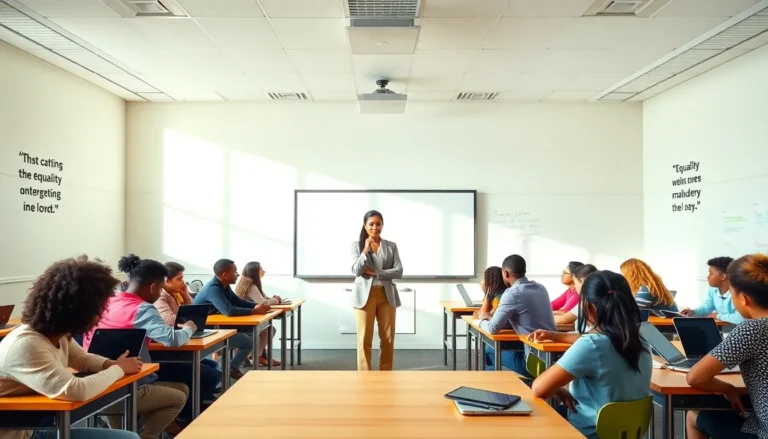Education is supposed to be the great equalizer, but anyone who’s sampled the cafeteria food knows that’s about as likely as finding a unicorn in a schoolyard. Today’s education landscape is fraught with challenges that can put even the most optimistic teachers in a tailspin. From inequities to technology overload, the issues are vast and complex, yet they also present an opportunity to rethink and reshape how we learn. So buckle up as we jump into the perplexing but intriguing realm of education issues today.
Table of Contents
ToggleOverview of Current Education Landscape

The landscape of education today resembles a patchwork quilt, each square telling a unique story. At its core, education strives to equip individuals with the skills and knowledge they need to navigate the world. But, multiple factors, political, social, and economic, are weaving together a narrative of crisis.
Statistics show that across the globe, educational attainment varies dramatically. In some areas, students thrive, while in others, they struggle to grasp basic literacy skills. This disparity raises questions about fairness and equality, compelling educators and policymakers to rethink what needs to be done.
Besides, the pandemic highlighted these disparities, forcing schools to switch to remote learning almost overnight. While some schools adapted seamlessly, others encountered a wall of challenges. This shift has left many wondering about the future of education: How can we make it more inclusive and effective for everyone?
Inequities in Access to Education
Inequities in education remain a pressing issue. The gap between affluent and underprivileged communities is as visible as chalk on a blackboard. Many students from low-income families face obstacles such as lack of technological access, insufficient learning resources, and overcrowded classrooms.
Research indicated that students in underfunded schools often have to make do with outdated textbooks or inadequate facilities. While some students engage with engaged teachers in state-of-the-art classrooms, others struggle to learn in environments that barely meet basic educational standards.
Also, marginalized groups often face additional barriers, such as systemic discrimination. Educational inequity is not merely a statistic: it’s a lived reality that has substantial consequences for millions of young minds.
Impact of Technology on Learning
Technology in education can be the fairy godmother or the wicked stepmother, it all depends on how it’s used. On one hand, advancements in educational technology have the potential to revolutionize learning experiences. Online resources and interactive tools can engage students in ways traditional methods often cannot.
But, the rapid pace of technological change can also create a digital divide. Not every student has the same access to reliable internet connections or modern devices, which unfortunately amplifies existing inequalities. Also, as students spend more time online, issues such as screen fatigue and cyberbullying may arise, leading to more questions about the role of technology in education.
Technology isn’t just a tool, it’s a double-edged sword that requires careful handling.
Curriculum Relevance and Adaptation
A curriculum is like a map: it needs to be updated to guide students through contemporary landscapes. Unfortunately, many curricula fail to reflect the realities students face today. Knowledge is evolving at a dizzying pace while outdated lesson plans linger in classrooms.
This disconnection poses a significant challenge. Students often disengage when they fail to see the relevance of what they’re learning. An emphasis on standardized testing has led some institutions to focus on rote memorization rather than fostering critical thinking skills and creativity.
Also, the rising need for skills in digital literacy, social-emotional learning, and entrepreneurship highlights the necessity for curricula that adapt to these demands. Educators should aim to instill a love for learning by connecting lessons to real-world issues.
Mental Health and Student Well-Being
Mental health is emerging as a critical educational issue in today’s climate. With increased pressures from various fronts, academic, social, and digital, students often find themselves battling anxiety and stress. The stigma surrounding mental health issues may prevent many from seeking help, and inadequate support systems in schools only exacerbate the situation.
Educators and administrators have a vital role to play in creating environments that prioritize mental well-being. Initiatives such as mindfulness practices, counseling services, and social-emotional learning programs can significantly benefit students.
The conversation surrounding mental health is expanding, and it’s becoming clear that a healthy mind is as essential for academic success as any textbook knowledge. Schools must become supportive havens where students feel safe to express their struggles.
Teacher Shortages and Support Systems
Teacher shortages are no longer a hidden problem: they’ve become a glaring issue. A cascade of retirements and a lack of new educators entering the field have left many schools scrambling to find qualified staff. This shortage can dilute the quality of education and leave teachers overworked, leading to burnout.
Support systems for educators are paramount in addressing this crisis. Professional development, mentorship programs, and attractive compensation packages can enhance job satisfaction and retention. Schools that invest in their teachers eventually invest in their students.
Besides, prioritizing teacher well-being can create a ripple effect, ensuring that students receive high-quality education even amid the ongoing challenges in the workforce.
Future Trends in Education
As the old adage goes, the only constant is change, and the education sector is no exception. Innovative teaching methods, integration of artificial intelligence, and a focus on lifelong learning are setting the stage for a transformative future. Personalized learning experiences based on individual student needs represent an exciting frontier.
Also, the rise of hybrid learning models acknowledges that education doesn’t have to be confined to the traditional classroom. As students have become accustomed to flexibility, educational establishments are rethinking strategies to accommodate diverse learning styles.
Looking ahead, collaboration between educational institutions, tech companies, and policymakers will prove essential. As new trends emerge, it’s crucial to keep the dialogue open and address challenges collectively.



